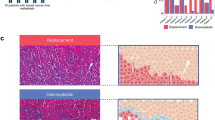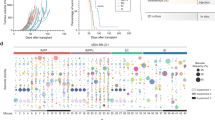Abstract
Advanced breast cancer often spreads to the bone, brain, liver, and lungs. The survival time of a patient with breast cancer liver metastasis is often less than 9 months without treatment. Experimental model systems often focus on the lung as a site of metastatic relapse, and therefore, there is less of an understanding of the biological processes that occur during expansive liver metastasis growth. In these studies, 14 genetically distinct breast cancer patient-derived xenografts (PDXs) were characterized for growth in the liver after portal vein injection of cancer cells. Growth in the liver occurred in 12 of 14 models, and the relative growth rate across the PDXs was overall similar to growth in the mammary gland. Pathological and immunohistochemical analyses revealed that the proliferation rates of metastases were relatively similar as the metastases expanded until the tumors became necrotic, and then slightly lower proliferation rates were observed. There were influxes of macrophages and neutrophils as the metastases increased in size, suggesting these innate immune cells may result in differential responses to therapeutics in micrometastases compared to macrometastases. The development and characterization of these models is important as future studies can utilize this information to determine if targeted therapies can slow the progression of metastatic disease at different stages in the liver.







Similar content being viewed by others
References
Redig AJ, McAllister SS (2013) Breast cancer as a systemic disease: a view of metastasis. J Intern Med 274(2):113–126
Perou CM, Sørlie T, Eisen MB, van de Rijn M, Jeffrey SS, Rees CA et al (2000) Molecular portraits of human breast tumours. Nature 406(6797):747–752
Sørlie T, Perou CM, Tibshirani R, Aas T, Geisler S, Johnsen H et al (2001) Gene expression patterns of breast carcinomas distinguish tumor subclasses with clinical implications. Proc Natl Acad Sci USA 98(19):10869–10874
Yersal O, Barutca S (2014) Biological subtypes of breast cancer: prognostic and therapeutic implications. World J Clin Oncol 5(3):412–424
Curtis C, Shah SP, Chin S-F, Turashvili G, Rueda OM, Dunning MJ et al (2012) The genomic and transcriptomic architecture of 2000 breast tumours reveals novel subgroups. Nature 486(7403):346–352
Kennecke H, Yerushalmi R, Woods R, Cheang MCU, Voduc D, Speers CH et al (2010) Metastatic behavior of breast cancer subtypes. J Clin Oncol 28(20):3271–3277
Harrell JC, Prat A, Parker JS, Fan C, He X, Carey L et al (2012) Genomic analysis identifies unique signatures predictive of brain, lung, and liver relapse. Breast Cancer Res Treat 132(2):523–535
Polyak K (2011) Heterogeneity in breast cancer. J Clin Invest 121(10):3786–3788
Lehmann BD, Bauer JA, Chen X, Sanders ME, Chakravarthy AB, Shyr Y et al (2011) Identification of human triple-negative breast cancer subtypes and preclinical models for selection of targeted therapies. J Clin Invest 121(7):2750–2767
Bareche Y, Venet D, Ignatiadis M, Aftimos P, Piccart M, Rothe F et al (2018) Unravelling triple-negative breast cancer molecular heterogeneity using an integrative multiomic analysis. Ann Oncol 29(4):895–902
Gonçalves H, Guerra MR, Cintra JRD, Fayer VA, Brum IV, Teixeira MTB (2018) Survival study of triple-negative and non-triple-negative breast cancer in a Brazilian cohort. Clin Med Insights Oncol 12:1179554918790563
Ma R, Feng Y, Lin S, Chen J, Lin H, Liang X et al (2015) Mechanisms involved in breast cancer liver metastasis. J Transl Med 13:64
Tobin NP, Harrell JC, Lövrot J, Brage SE, Stolt MF, Carlsson L et al (2015) Molecular subtype and tumor characteristics of breast cancer metastases as assessed by gene expression significantly influence patient post-relapse survival. Ann Oncol 26(1):81–88
Treska V, Cerna M, Liska V, Treskova I, Narsanska A, Bruha J (2014) Surgery for breast cancer liver metastases—factors determining results. Anticancer Res 34(3):1281–1286
Alzubi MA, Turner TH, Olex AL, Sohal SS, Tobin NP, Recio SG et al (2019) Separation of breast cancer and organ microenvironment transcriptomes in metastases. Breast Cancer Res. https://breast-cancer-research.biomedcentral.com/articles/10.1186/s13058-019-1123-2. Accessed 6 Mar 2019
DeRose YS, Wang G, Lin Y-C, Bernard PS, Buys SS, Ebbert MTW et al (2011) Tumor grafts derived from women with breast cancer authentically reflect tumor pathology, growth, metastasis and disease outcomes. Nat Med 17(11):1514–1520
Kabos P, Finlay-Schultz J, Li C, Kline E, Finlayson C, Wisell J (2012) Patient-derived luminal breast cancer xenografts retain hormone receptor heterogeneity and help define unique estrogen-dependent gene signatures. Breast Cancer Res Treat 135(2):415
Huang K-L, Li S, Mertins P, Cao S, Gunawardena HP, Ruggles KV et al (2017) Proteogenomic integration reveals therapeutic targets in breast cancer xenografts. Nat Commun 8:14864
Haffty BG, Yang Q, Reiss M, Kearney T, Higgins SA, Weidhaas J et al (2006) Locoregional relapse and distant metastasis in conservatively managed triple negative early-stage breast cancer. J Clin Oncol 24(36):5652–5657
Kassam F, Enright K, Dent R, Dranitsaris G, Myers J, Flynn C et al (2009) Survival outcomes for patients with metastatic triple-negative breast cancer: implications for clinical practice and trial design. Clinical Breast Cancer 9(1):29–33
Frentzas S, Simoneau E, Bridgeman VL, Vermeulen PB, Foo S, Kostaras E et al (2016) Vessel co-option mediates resistance to anti-angiogenic therapy in liver metastases. Nat Med 22(11):1294–1302
Turner TH, Alzubi MA, Sohal SS, Olex AL, Dozmorov MG, Harrell JC (2018) Characterizing the efficacy of cancer therapeutics in patient-derived xenograft models of metastatic breast cancer. Breast Cancer Res Treat 170(2):221–234
Mills MN, Yang GQ, Oliver DE, Liveringhouse CL, Ahmed KA, Orman AG et al (2018) Histologic heterogeneity of triple negative breast cancer: a national cancer centre database analysis. Eur J Cancer 98:48–58
Abramson VG, Mayer IA (2014) Molecular heterogeneity of triple negative breast cancer. Curr Breast Cancer Rep 6(3):154–158
Zimmermann A (2017) Metastatic liver disease: secondary alterations of hepatic metastases. In: Zimmermann A (ed) Tumors and tumor-like lesions of the hepatobiliary tract: general and surgical pathology. Cham: Springer, pp 1947–1964. https://doi.org/10.1007/978-3-319-26956-6_109. Accessed 10 Mar 2019
Fitzgibbons PL, Page DL, Weaver D, Thor AD, Allred DC, Clark GM et al (2000) Prognostic factors in breast cancer. College of American Pathologists Consensus Statement. Arch Pathol Lab Med 124(7):966–978
Fujii T, Le Du F, Xiao L, Kogawa T, Barcenas CH, Alvarez RH et al (2015) Effectiveness of an adjuvant chemotherapy regimen for early-stage breast cancer: a systematic review and network meta-analysis. JAMA Oncol 1(9):1311–1318
Coffelt SB, Wellenstein MD, de Visser KE (2016) Neutrophils in cancer: neutral no more. Nat Rev Cancer 16(7):431–446
Fridlender ZG, Sun J, Kim S, Kapoor V, Cheng G, Ling L et al (2009) Polarization of tumor-associated neutrophil phenotype by TGF-beta: “N1” versus “N2” TAN. Cancer Cell 16(3):183–194
Tabariès S, Ouellet V, Hsu BE, Annis MG, Rose AAN, Meunier L et al (2015) Granulocytic immune infiltrates are essential for the efficient formation of breast cancer liver metastases. Breast Cancer Res 17:45
Averill MM, Barnhart S, Becker L, Li X, Heinecke JW, Leboeuf RC et al (2011) S100A9 differentially modifies phenotypic states of neutrophils, macrophages, and dendritic cells: implications for atherosclerosis and adipose tissue inflammation. Circulation 123(11):1216–1226
Wculek SK, Malanchi I (2015) Neutrophils support lung colonization of metastasis-initiating breast cancer cells. Nature 528(7582):413–417
Gordon S, Martinez-Pomares L (2017) Physiological roles of macrophages. Pflugers Arch 469(3–4):365–374
Qian B-Z, Pollard JW (2010) Macrophage diversity enhances tumor progression and metastasis. Cell 141(1):39–51
Acknowledgements
Paraffin embedding services in support of the research project were provided by the Cancer Mouse Models Shared Resource Core supported, in part, with funding from NIH-NCI Cancer Center Support Grant P30 CA016059.
Funding
This work was supported by funds to JCH by METAvivor and the VCU Massey Cancer Center, and to THT from a NCI F30 grant (1F30CA228393-01A1).
Author information
Authors and Affiliations
Contributions
Designed experiments; MAA, JCH. Performed animal experiments; MAA. Performed tumor cell preparations; MAA, THT. Performed immunohistochemical experiments and analyzed data; SSS, MAA, MS. Pathological review PZ, MOI. Wrote the manuscript; SSS, JCH. Supervised the study; JCH. All authors reviewed and edited the manuscript.
Corresponding author
Ethics declarations
Conflict of interest
The authors declare no potential conflicts of interest.
Ethics approval
All applicable international, national, and/or institutional guidelines for the care and use of animals were followed and approved by the Virginia Commonwealth University Institutional Animal Care and Use Committees.
Additional information
Publisher's Note
Springer Nature remains neutral with regard to jurisdictional claims in published maps and institutional affiliations.
Electronic supplementary material
Below is the link to the electronic supplementary material.
Rights and permissions
About this article
Cite this article
Alzubi, M.A., Sohal, S.S., Sriram, M. et al. Quantitative assessment of breast cancer liver metastasis expansion with patient-derived xenografts. Clin Exp Metastasis 36, 257–269 (2019). https://doi.org/10.1007/s10585-019-09968-z
Received:
Accepted:
Published:
Issue Date:
DOI: https://doi.org/10.1007/s10585-019-09968-z




